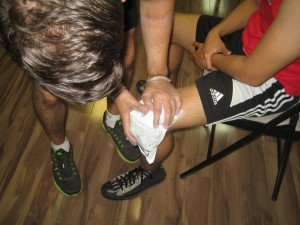Soft tissue injuries include bumps, and bruises (contusion) and small tears of muscles (minor strains) or of ligaments (minor sprains). Tissue injuries may be caused by direct or indirect trauma resulting to tissue dysfunction and may result to pain, inflammation and internal tissue stress. The injury would usually result to functional disabilities.
Contusions, mild strains and mild sprains produce mild to moderate pain and swelling. The swelling can become discolored, turning purple after a day, becoming yellow or brown days after. The person usually can continue using the body part that was injured. People with more severe symptoms such as pain, deformity, or an inability to walk or use an injured part may have as mild strain or sprain. However, some may also have complete separation of bones that were attached within a joint (dislocation), partial separation of bones that were attached within a joint (subluxation), fracture or other severe injury. People with severe symptoms usually need professional medical care to determine the name of the injury.
First aid treatment for soft tissue injuries
Soft tissue injuries such as contusions, mild strains and mild sprains can be treated with first aid at home with rest, ice, compression and elevation. If a fracture, a severe strain, severe sprain, subluxation, or dislocation is a possibility, a splint should be applied until professional help is available. When a person had a soft tissue injury, one should:

- Apply ice immediately on the affected area or where the swelling is. The ice should not be applied directly, but should be wrapped in cloth.
- Wrap the affected area with a roller bandage to immobilize the area. The affected area should be wrapped snugly and it should not impede the blood flow to that area. One may also use a splint to limit the movement of the area.
- The affected part should also be elevated above the heart level to reduce swelling
- The affected area should also be rested for several days
Commonly used splints
A splint can be anything that prevents movement of a limb. A splint is used to prevent further damage and limit pain. To be effective, a splint must immobilize the joints above and below the injury. Splints can be made from readily available objects, such as magazine or stack of newspapers. But splints usually consist of a rigid, straight object, such as board strapped to the limb. A slipknot may be used with a splint to support the forearm when an arm, a wrist, or the collarbone is injured.
Reference:
NFTI Training. Soft Tissue Injuries. Retrieved on June 14, 2014 from http://www.nfti.edu.au/AboutUs/FirstAidTips-15/SoftTissueInjuries-369/

